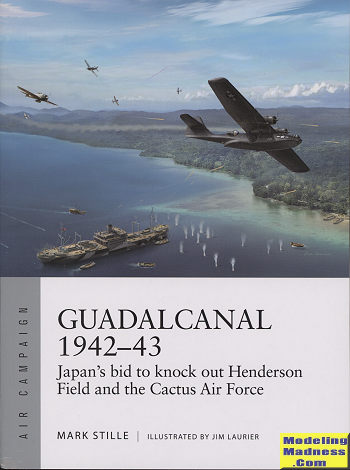 America's
first offensive action of the Pacific War and WWII in general was the invasion
of Guadalcanal in the southwest Pacific. It was fairly obvious the the Japanese
were planning on extending their influence in an attempt to isolate Australia.
The Japanese never seriously considered invading Australia due to a lack of
manpower, but it was important that they not be able to interfere in the
territory already conquered to the north and northeast.
America's
first offensive action of the Pacific War and WWII in general was the invasion
of Guadalcanal in the southwest Pacific. It was fairly obvious the the Japanese
were planning on extending their influence in an attempt to isolate Australia.
The Japanese never seriously considered invading Australia due to a lack of
manpower, but it was important that they not be able to interfere in the
territory already conquered to the north and northeast.
Guadalcanal was a Navy operation, but it took some wrangling
for that to happen as parts of the Solomons were under the command of McArthur
and the Army. Nimitz did not want the hassles of dual command structures (and
probably didn't like McArthur) so convinced the joint chiefs to give that area
to the Navy.
Unknown to the US at the time, the Japanese had just started
landing troops on the island to build an airstrip. They also established a
seaplane base across the strait on Tulagi. The Marine landing on 7 August 1942
took the Japanese by surprise and the landing went unopposed. Most of the
Japanese on the airstrip were construction workers and they melted into the
jungle on the advance of US troops. The Japanese did have some forces on the
island, but underestimated the total number of Marines on the island. The
results of counterattacks were predictable and while some instances were close,
they were eventually failures. Thus began a piece-meal reinforcement policy that
did nothing to actually remove the US from the airfield.
The airfield was the key to the whole campaign as it allowed
the US to keep an eye on the Japanese and kept open the lines of communication
and supply to Australia. It was also the #1 reason that the Japanese were not able to reinforce or properlly supply the troops that were there. The Japanese sent bombing raids, sent heavy naval
forces and repeatedly attacked the Marine perimeter, but nothing was successful.
Had they sent in a large number of forces early, the outcome may have been
different, but they didn't and the rest is history.
The author does a great job of covering the campaign and for
the most part, keeps focused on the air aspect of it. It was the air war over
and for the island that was the telling feature of the campaign. Japanese air
attacks were generally ineffective and lost the cream of the crop for the
Japanese Naval air forces. It also allowed US pilots to gain experience and
develop tactics against what was, until then, pretty much unbeatable Japanese
airpower. If Midway was the turning battle, then Guadalcanal was the turning
campaign of the Pacific war.
In line with other books in this series we have some great
art work, excellent maps and charts and a bevy of well chosen period
photographs. Guadalcanal has always been an interest of mine and this is an
excellent book on the subject. Highly recommended.
September 2019
For more on the complete line of Osprey books and to order
this one, visit
www.ospreypublishing.com
.
If you would like your product reviewed fairly and quickly, please contact
the editor or see other details in the Note to
Contributors.
 America's
first offensive action of the Pacific War and WWII in general was the invasion
of Guadalcanal in the southwest Pacific. It was fairly obvious the the Japanese
were planning on extending their influence in an attempt to isolate Australia.
The Japanese never seriously considered invading Australia due to a lack of
manpower, but it was important that they not be able to interfere in the
territory already conquered to the north and northeast.
America's
first offensive action of the Pacific War and WWII in general was the invasion
of Guadalcanal in the southwest Pacific. It was fairly obvious the the Japanese
were planning on extending their influence in an attempt to isolate Australia.
The Japanese never seriously considered invading Australia due to a lack of
manpower, but it was important that they not be able to interfere in the
territory already conquered to the north and northeast.